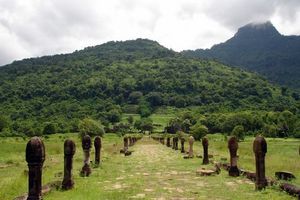Advertisement

 The Ceremonial Road leading up to Wat Phu
The Ceremonial Road leading up to Wat Phu
The two Barays either side are man-made reservoirs and were used by worshippers to wash themselves before entering the temple. The water was also used to irrigate the surrounding land Champasak was a bit of an experience. Well the getting to and fro bit. It all started with the guy at the travel company in Pakse proclaiming on the day that we had arranged to leave that he had no minibuses today! (NICE ONE MATE!) The only alternative was for us to take the local bus service…… The pictures tell the story. 26 adults and 6 kids, along with the fruit and veg counter of Sainsbury’s all packed into a little van!! It wasn’t as bad as it looked (apart from the sleeping lady on my shoulder!). Even with a pit stop to change a burst rear tyre that would have had Bernie Ecclestone salivating! It was that quick! We got to Champasak a lot faster than we thought.
Champasak is a little bit off the normal route, but like most things that are; it was well worth the effort. It’s pretty basic, but what it doesn’t have in mod cons it makes up for in character and charm. Champasak is on the Thai side of the Mekong River not far from the border and consequently we needed to take the free ferry crossing to reach the town. The

 Tier one - The South Worship Pavilion
Tier one - The South Worship Pavilion
Worship Pavilions were thought to be used for ceremonial purposes, such as preparing offerings to present to the gods in the temples or hosting worshippers during special ceremonial events.town itself runs along one main road with buildings on either side. The houses double as shops and restaurants with temples popping up every Kilometer or so. To one side the houses back onto the Mekong River with rear stilted terraces over looking the water and often a little jetty with a wooden long boat moored ready for a spot of fishing. To the other side rice paddies and shrub land slip away behind the houses until they reach the distant cloud covered hills. As I said it’s basic but peaceful and very pretty.
It didn’t take long to find a place to stay thanks to the foresight of our host. For the first time ever, we were thankful for him touting his guesthouse when we got off the bus. For a few dollars less than our intended guesthouse, he offered the same facilities with the added bonus of a free tuk tuk service from the ferry.
Now that we had that sorted we could get on with finding out about the whole reason why we were here. Wat Phu. Wat Phu is billed as the most impressive Khmer temple outside of Cambodia. UNESCO World Heritage listed, Wat
Phu was constructed in the 5th century by Suryavarman II the guy who was later responsible for building Angkor Wat.
But in this instance rather than nature constructing itself around the ruins, as it has to give the impressive results now seen at Angkor Wat, the construction of Wat Phu was deliberately integrated into the landscape from the start, in a manner unlike any other.
The site stretches some 1,400 metres eastwards from the foot of Phu Kao (the mountain it backs onto) down to the banks of the Mekong River. It comprises of a collection of temples, shrines and waterworks. The alignment and placement of these features were intended to replicate the Khmer understanding of the universe and of heaven. The ancient Khmer believed that living in such a place would guarantee harmony in their lives.
Being there and looking out over the complex from the temple at the top it is easy to see how well they had understood their brief. The place was so peaceful you can only imagine how mesmerizing it would have been in its former glory.
For sure, it was worth the 20k round trip bicycle ride. Although that itself
was good fun, leisurely cruising past the villages that lined the road to the temple, looking in at the goings on, watching the locals go about their daily business, which from our accounts involved eating, farming, or lying out on their day beds. The kids were cool though and in most cases they would give a big smile and shout Sabadee (hello) as you ride past.
There isn’t a great deal to do here other than visit the ruins or go hiking in the hills. Well apart from just sitting back on a hammock over looking the River watching all the fishing boats bob up and down. I bet you can’t guess which of the last two we did over the rest of our three days here?
Advertisement
Tot: 0.417s; Tpl: 0.017s; cc: 32; qc: 105; dbt: 0.364s; 1; m:domysql w:travelblog (10.17.0.13); sld: 1;
; mem: 1.3mb

 The Ceremonial Road leading up to Wat Phu
The Ceremonial Road leading up to Wat Phu
 Tier one - The South Worship Pavilion
Tier one - The South Worship Pavilion






